High Thermal Conductivity and Anisotropy Values of Aligned Graphite Flakes/Copper Foil Composites
Abstract
:1. Introduction
2. Materials and Methods
2.1. Materials and Reagents
2.2. Cu Coating Grown on the Surface of GFs
2.3. Tape Casting Process
2.4. Preparation of GFs/Cu Composites
2.5. Material Characterization
3. Results and Discussion
3.1. Microstructure of Materials and Composites
3.2. Quantitative Analysis of GFs Alignment
3.3. Thermal Properties and Modeling
4. Conclusions
Author Contributions
Funding
Conflicts of Interest
References
- Mallik, S.; Ekere, N.; Best, C.; Bhatti, R. Investigation of thermal management materials for automotive electronic control units. Appl. Therm. Eng. 2011, 31, 355–362. [Google Scholar] [CrossRef] [Green Version]
- Qu, X.H.; Zhang, L.; Wu, M.; Ren, S.B. Review of metal matrix composites with high thermal conductivity for thermal management applications. Prog. Nat. Sci. Mater. Int. 2011, 21, 189–197. [Google Scholar] [CrossRef] [Green Version]
- Shu, S.; Yang, H.; Tong, C.; Qiu, F. Fabrication of TiCx-TiB(2)/Al Composites for Application as a Heat Sink. Materials 2016, 9, 642. [Google Scholar] [CrossRef] [PubMed] [Green Version]
- Wu, D.; Huang, C.; Wang, Y.; An, Y.; Guo, C. Utilization of SiC and Cu Particles to Enhance Thermal and Mechanical Properties of Al Matrix Composites. Materials 2019, 12, 2770. [Google Scholar] [CrossRef] [PubMed] [Green Version]
- Chu, K.; Wang, X.H.; Li, Y.B.; Huang, D.J.; Geng, Z.R.; Zhao, X.L.; Liu, H.; Zhang, H. Thermal properties of graphene/metal composites with aligned graphene. Mater. Des. 2018, 140, 85–94. [Google Scholar] [CrossRef]
- Han, X.; Huang, Y.; Zhou, S.; Sun, X.; Peng, X.; Chen, X. Effects of graphene content on thermal and mechanical properties of chromium-coated graphite flakes/Si/Al composites. J. Mater. Sci. 2017, 29, 4179–4189. [Google Scholar] [CrossRef]
- Chen, J.K.; Huang, I.S. Thermal properties of aluminum–graphite composites by powder metallurgy. Compos. Part B Eng. 2013, 44, 698–703. [Google Scholar] [CrossRef]
- Xue, C.; Bai, H.; Tao, P.F.; Wang, J.W.; Jiang, N.; Wang, S.L. Thermal conductivity and mechanical properties of flake graphite/Al composite with a SiC nano-layer on graphite surface. Mater. Des. 2016, 108, 250–258. [Google Scholar] [CrossRef]
- Saadallah, S.; Cablé, A.; Hamamda, S.; Chetehouna, K.; Sahli, M.; Boubertakh, A.; Revo, S.; Gascoin, N. Structural and thermal characterization of multiwall carbon nanotubes (MWCNTs)/aluminum (Al) nanocomposites. Compos. Part B Eng. 2018, 151, 232–236. [Google Scholar] [CrossRef]
- Kim, Y.S.; Kim, J.K.; Jeon, E.S. Effect of the Compounding Conditions of Polyamide 6, Carbon Fiber, and Al2O3 on the Mechanical and Thermal Properties of the Composite Polymer. Materials 2019, 12, 3047. [Google Scholar] [CrossRef] [Green Version]
- Monje, I.E.; Louis, E.; Molina, J.M. Interfacial nano-engineering in Al/diamond composites for thermal management by in situ diamond surface gas desorption. Scr. Mater. 2016, 115, 159–163. [Google Scholar] [CrossRef]
- Lindsay, L.; Broido, D.A.; Mingo, N. Diameter dependence of carbon nanotube thermal conductivity and extension to the graphene limit. Phys. Rev. B 2010, 82, 161402. [Google Scholar] [CrossRef]
- Chang, C.W.; Fennimore, A.M.; Afanasiev, A.; Okawa, D.; Ikuno, T.; Garcia, H.; Li, D.; Majumdar, A.; Zettl, A. Isotope effect on the thermal conductivity of boron nitride nanotubes. Phys. Rev. Lett. 2006, 97, 085901. [Google Scholar] [CrossRef] [PubMed] [Green Version]
- Emmerich, F.G. Young’s modulus, thermal conductivity, electrical resistivity and coefficient of thermal expansion of mesophase pitch-based carbon fibers. Carbon 2014, 79, 274–293. [Google Scholar] [CrossRef]
- Balandin, A.A.; Ghosh, S.; Bao, W.; Calizo, I.; Teweldebrhan, D.; Miao, F.; Lau, C.N. Superior Thermal Conductivity of Single-Layer Graphene. Nano Lett. 2008, 8, 902–907. [Google Scholar] [CrossRef]
- Balandin, A.A. Thermal properties of graphene and nanostructured carbon materials. Nat. Mater. 2011, 10, 569–581. [Google Scholar] [CrossRef] [Green Version]
- Norley, J. The role of natural graphite in electronics cooling. Electron. Cool. 2001, 7, 50–51. [Google Scholar]
- Yuan, G.; Li, X.; Dong, Z.; Westwood, A.; Cui, Z.; Cong, Y.; Du, H.; Kang, F. Graphite blocks with preferred orientation and high thermal conductivity. Carbon 2012, 50, 175–182. [Google Scholar] [CrossRef]
- Jiang, L.; Wang, P.; Xiu, Z.; Chen, G.; Lin, X.; Dai, C.; Wu, G. Interfacial characteristics of diamond/aluminum composites with high thermal conductivity fabricated by squeeze-casting method. Mater. Charact. 2015, 106, 346–351. [Google Scholar] [CrossRef]
- Wang, P.; Xiu, Z.; Jiang, L.; Chen, G.; Lin, X.; Wu, G. Enhanced thermal conductivity and flexural properties in squeeze casted diamond/aluminum composites by processing control. Mater. Des. 2015, 88, 1347–1352. [Google Scholar] [CrossRef]
- Naddaf, A.; Zeinali Heris, S. Experimental study on thermal conductivity and electrical conductivity of diesel oil-based nanofluids of graphene nanoplatelets and carbon nanotubes. Int. Commun. Heat Mass 2018, 95, 116–122. [Google Scholar] [CrossRef]
- Li, N.; Wang, L.; Dai, J.; Wang, X.; Wang, J.; Kim, M.J.; Zhang, H. Interfacial products and thermal conductivity of diamond/Al composites reinforced with ZrC-coated diamond particles. Diam. Relat. Mater. 2019, 100, 107565. [Google Scholar] [CrossRef]
- Bai, H.; Xue, C.; Lyu, J.L.; Li, J.; Chen, G.X.; Yu, J.H.; Lin, C.T.; Lv, D.J.; Xiong, L.M. Thermal conductivity and mechanical properties of flake graphite/copper composite with a boron carbide-boron nano-layer on graphite surface. Compos. Part A Appl. Sci. Manuf. 2018, 106, 42–51. [Google Scholar] [CrossRef]
- Zhu, Y.; Bai, H.; Xue, C.; Zhou, R.; Xu, Q.; Tao, P.; Wang, C.; Wang, J.; Jiang, N. Thermal conductivity and mechanical properties of a flake graphite/Cu composite with a silicon nano-layer on a graphite surface. RSC Adv. 2016, 6, 98190–98196. [Google Scholar] [CrossRef]
- Liu, Q.; He, X.-B.; Ren, S.-B.; Zhang, C.; Ting-Ting, L.; Qu, X.H. Thermophysical properties and microstructure of graphite flake/copper composites processed by electroless copper coating. J. Alloy. Compd. 2014, 587, 255–259. [Google Scholar] [CrossRef]
- Sohn, Y.; Han, T.; Han, J.H. Effects of shape and alignment of reinforcing graphite phases on the thermal conductivity and the coefficient of thermal expansion of graphite/copper composites. Carbon 2019, 149, 152–164. [Google Scholar] [CrossRef]
- Zhou, C.; Huang, W.; Chen, Z.; Ji, G.; Wang, M.L.; Chen, D.; Wang, H.W. In-plane thermal enhancement behaviors of Al matrix composites with oriented graphite flake alignment. Compos. Part B Eng. 2015, 70, 256–262. [Google Scholar] [CrossRef]
- Li, W.; Liu, Y.; Wu, G. Preparation of graphite flakes/Al with preferred orientation and high thermal conductivity by squeeze casting. Carbon 2015, 95, 545–551. [Google Scholar] [CrossRef]
- Xu, C.; Wu, G.; Liu, Z.; Wu, D.; Meek, T.; Han, Q. Preparation of copper nanoparticles on carbon nanotubes by electroless plating method. Mater. Res. Bull 2004, 39, 1499–1505. [Google Scholar] [CrossRef]
- Nan, C.-W.; Birringer, R.; Clarke, D.R.; Gleiter, H. Effective thermal conductivity of particulate composites with interfacial thermal resistance. J. Appl. Phys. 1997, 81, 6692–6699. [Google Scholar] [CrossRef]
- Chu, K.; Wang, X.H.; Wang, F.; Li, Y.-b.; Huang, D.J.; Liu, H.; Ma, W.L.; Liu, F.X.; Zhang, H. Largely enhanced thermal conductivity of graphene/copper composites with highly aligned graphene network. Carbon 2018, 127, 102–112. [Google Scholar] [CrossRef] [Green Version]
- Zhou, C.; Ji, G.; Chen, Z.; Wang, M.; Addad, A.; Schryvers, D.; Wang, H. Fabrication, interface characterization and modeling of oriented graphite flakes/Si/Al composites for thermal management applications. Mater. Des. 2014, 63, 719–728. [Google Scholar] [CrossRef]
- Molina, J.; Prieto, R.; Narciso, J.; Louis, E. The effect of porosity on the thermal conductivity of Al–12wt.% Si/SiC composites. Scr. Mater. 2009, 60, 582–585. [Google Scholar] [CrossRef]
- Ueno, T.; Yoshioka, T.; Ogawa, J.I.; Ozoe, N.; Sato, K.; Yoshino, K. Highly thermal conductive metal/carbon composites by pulsed electric current sintering. Synth. Met. 2009, 159, 2170–2172. [Google Scholar] [CrossRef]
- Swartz, E.T.; Pohl, R.O. Thermal boundary resistance. Rev. Mod. Phys. 1989, 61, 605–668. [Google Scholar] [CrossRef]
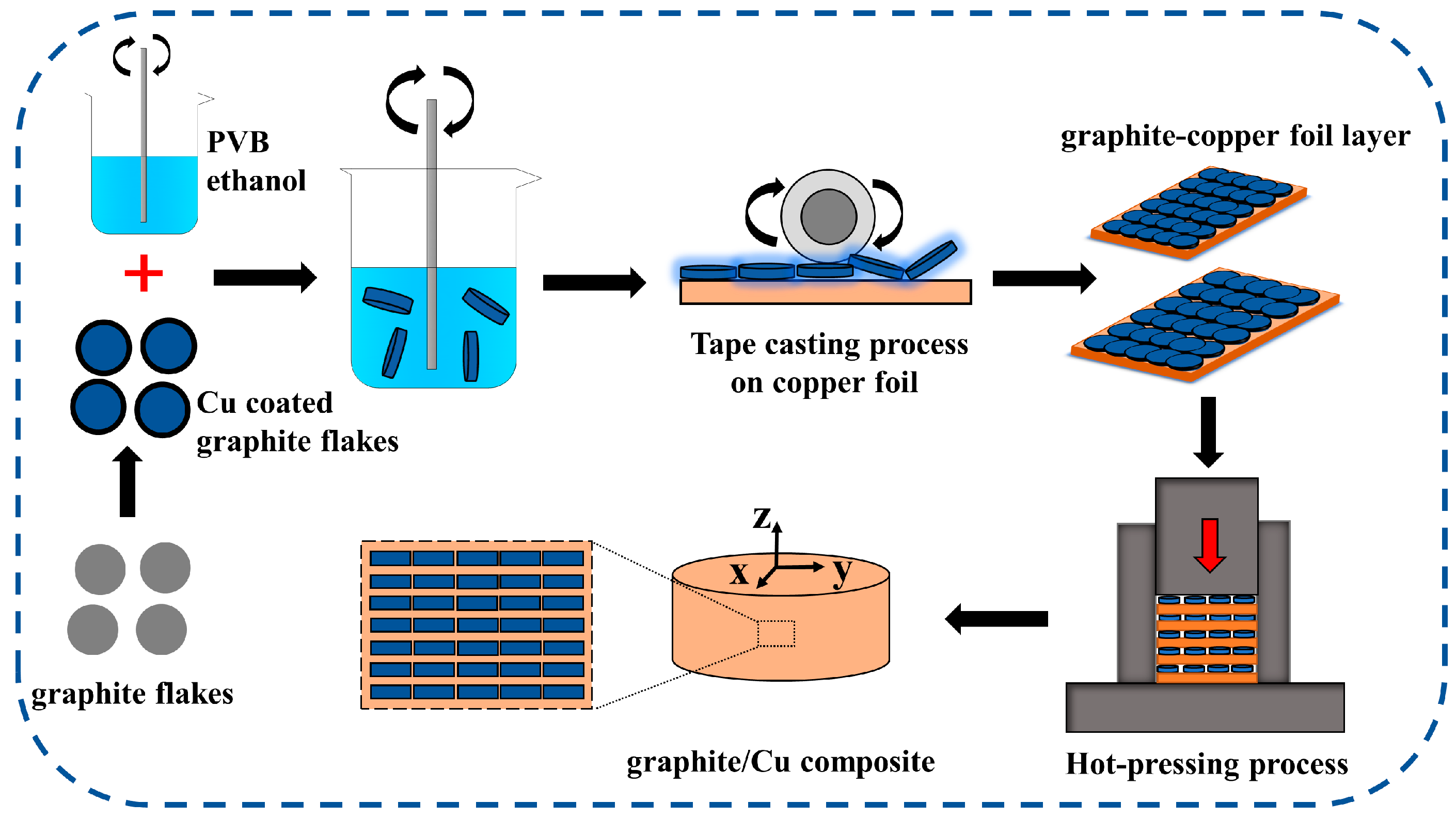
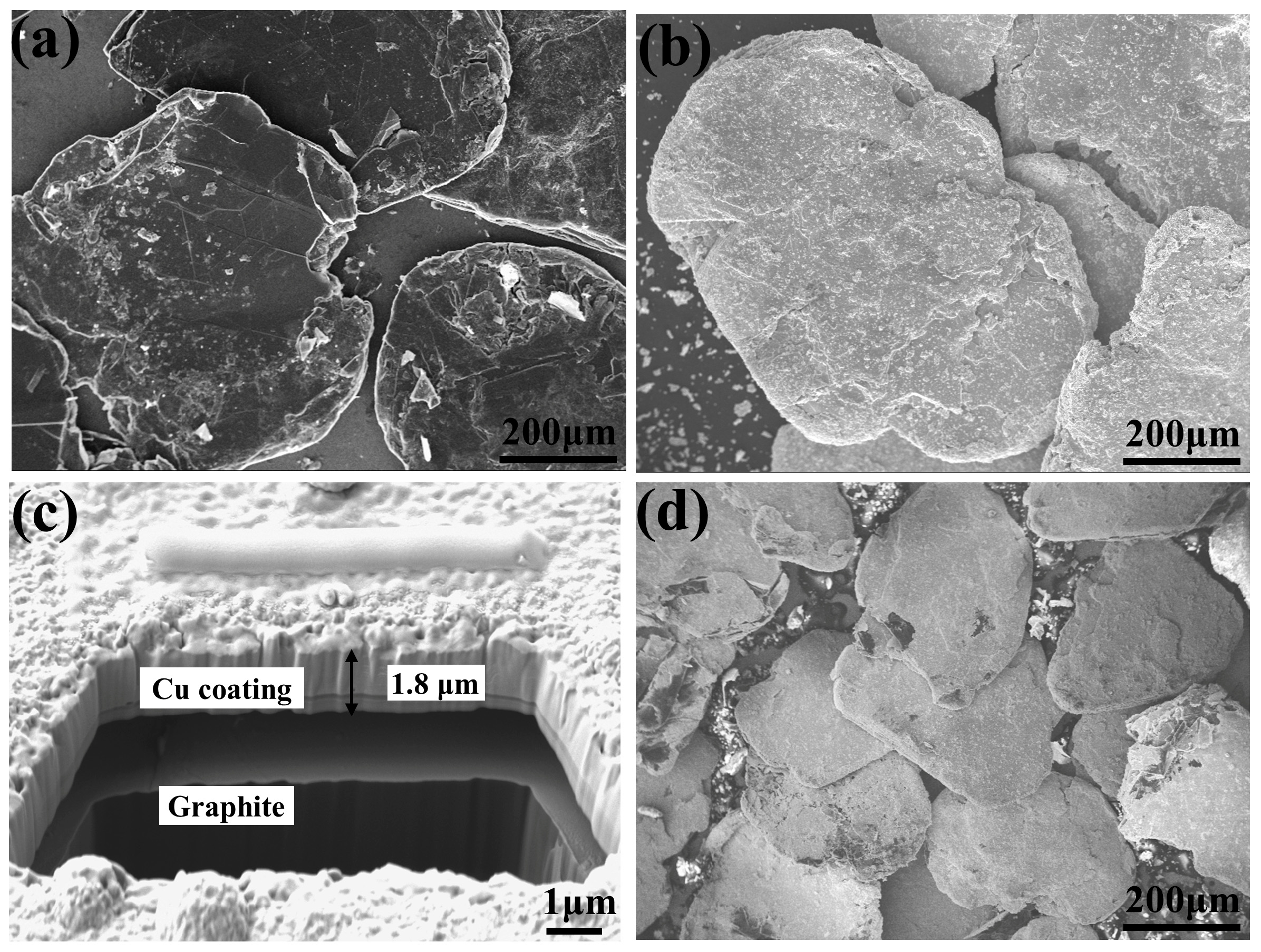
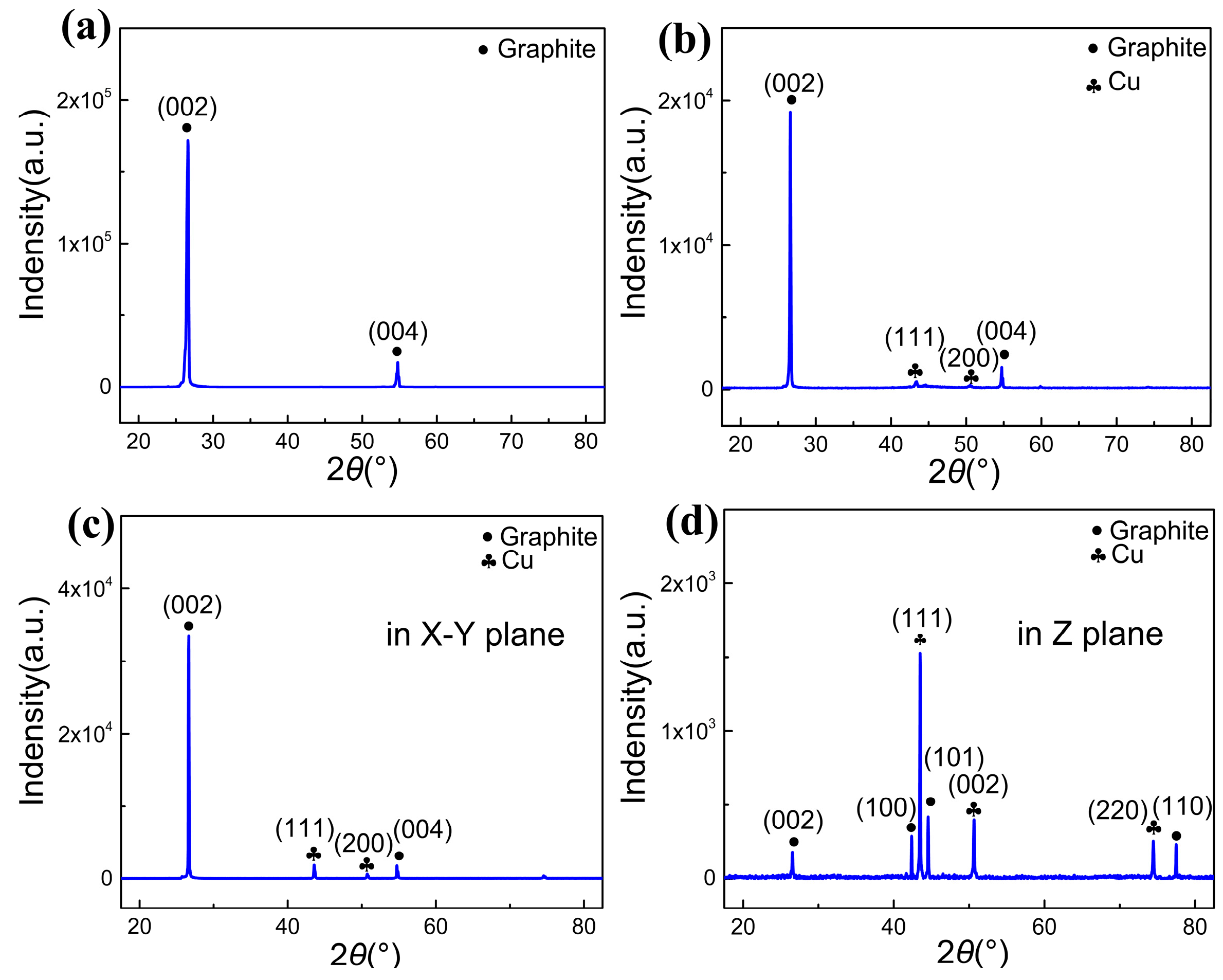
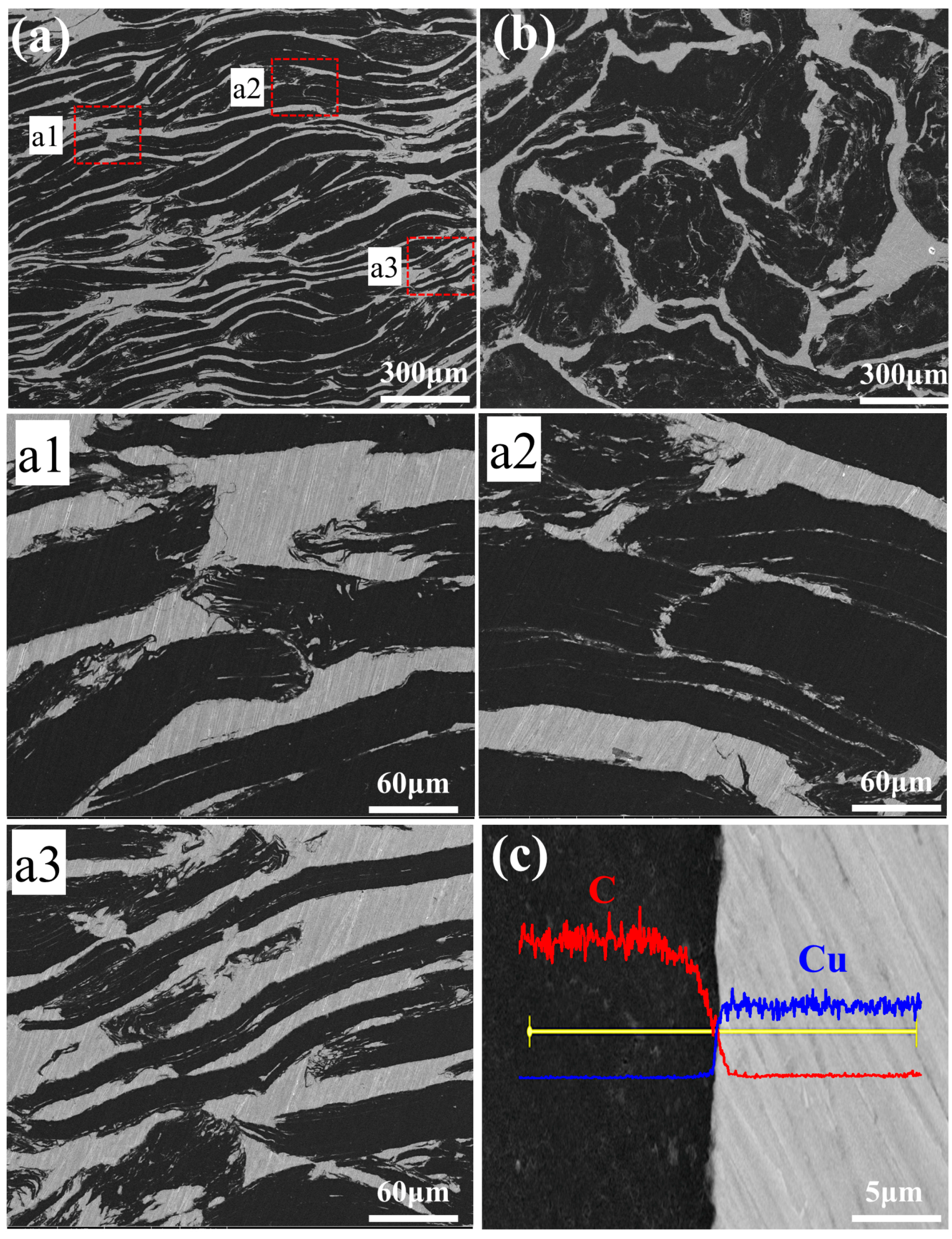
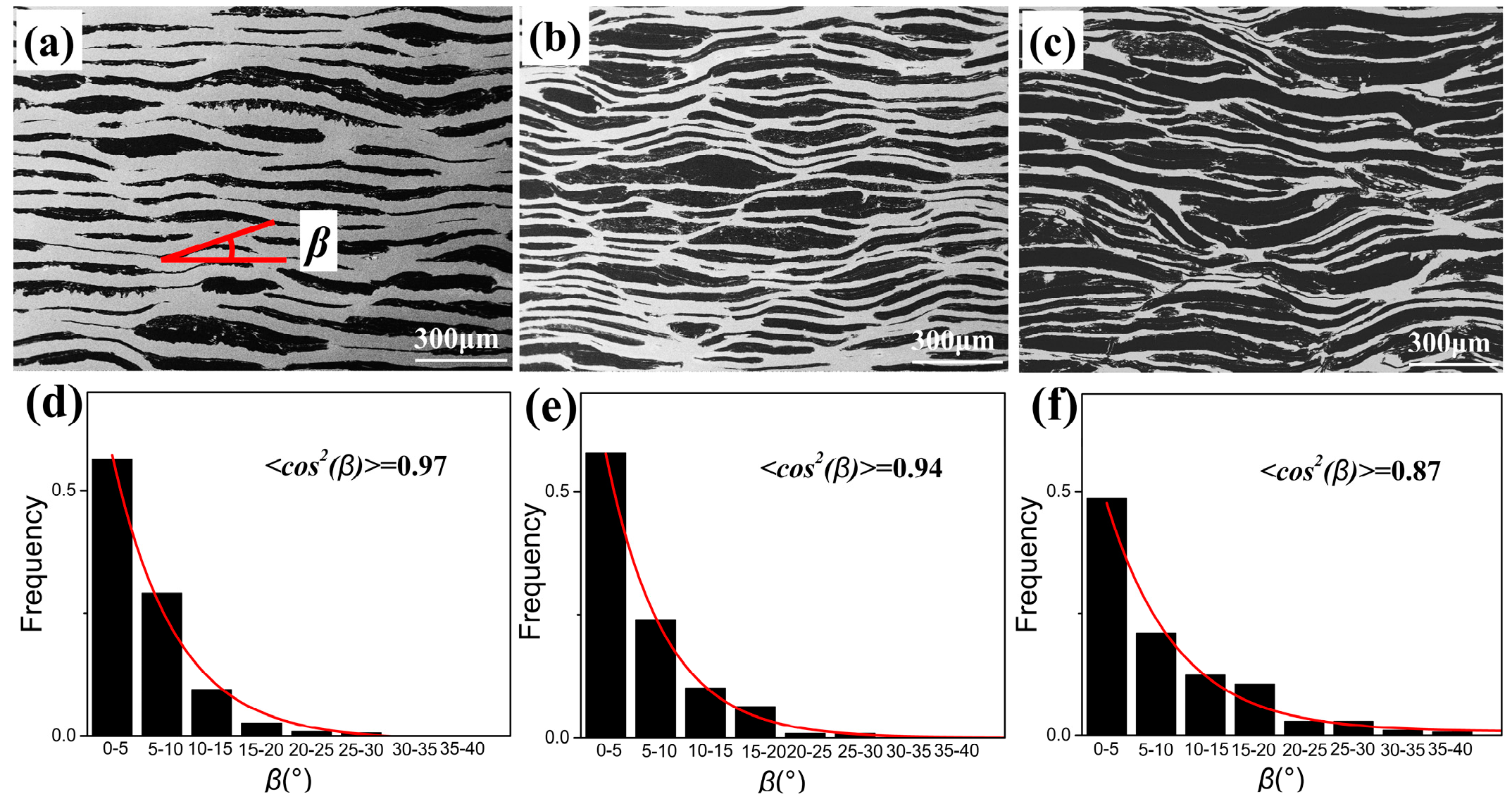
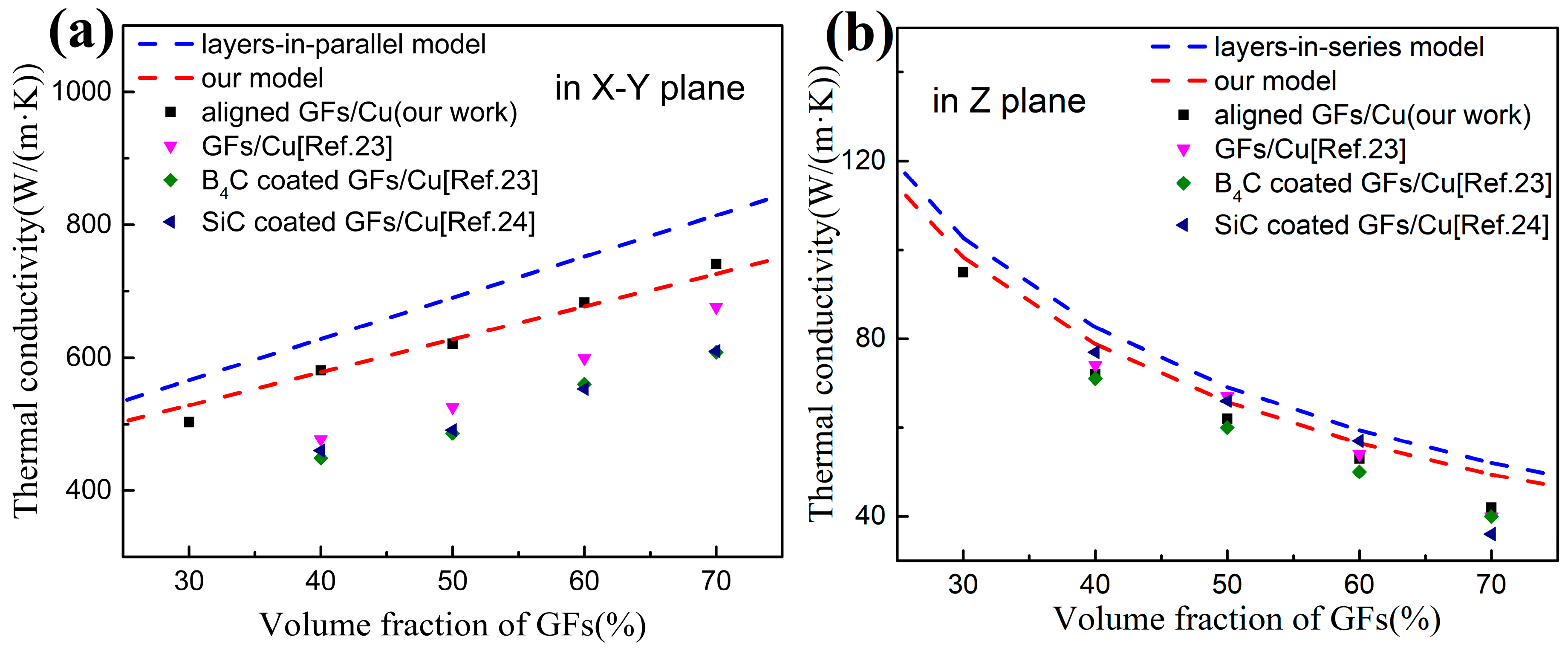
| Vg (%) | ρ (g/cm3) | Cp (J/(g·K)) | α(mm2/s) | TC(W/(m·K)) | <cos2β> | ||
|---|---|---|---|---|---|---|---|
| X–Y | Z | X–Y | Z | ||||
| 30 | 6.831 | 0.421 | 175 | 33 | 503 | 95 | 0.97 |
| 40 | 6.142 | 436 | 217 | 27 | 581 | 72 | 0.96 |
| 50 | 5.492 | 455 | 249 | 25 | 621 | 62 | 0.94 |
| 60 | 4.825 | 478 | 296 | 23 | 683 | 53 | 0.91 |
| 70 | 4.174 | 509 | 349 | 20 | 741 | 42 | 0.87 |
© 2019 by the authors. Licensee MDPI, Basel, Switzerland. This article is an open access article distributed under the terms and conditions of the Creative Commons Attribution (CC BY) license (http://creativecommons.org/licenses/by/4.0/).
Share and Cite
Zeng, F.; Xue, C.; Ma, H.; Lin, C.-T.; Yu, J.; Jiang, N. High Thermal Conductivity and Anisotropy Values of Aligned Graphite Flakes/Copper Foil Composites. Materials 2020, 13, 46. https://doi.org/10.3390/ma13010046
Zeng F, Xue C, Ma H, Lin C-T, Yu J, Jiang N. High Thermal Conductivity and Anisotropy Values of Aligned Graphite Flakes/Copper Foil Composites. Materials. 2020; 13(1):46. https://doi.org/10.3390/ma13010046
Chicago/Turabian StyleZeng, Fankun, Chen Xue, Hongbing Ma, Cheng-Te Lin, Jinhong Yu, and Nan Jiang. 2020. "High Thermal Conductivity and Anisotropy Values of Aligned Graphite Flakes/Copper Foil Composites" Materials 13, no. 1: 46. https://doi.org/10.3390/ma13010046





